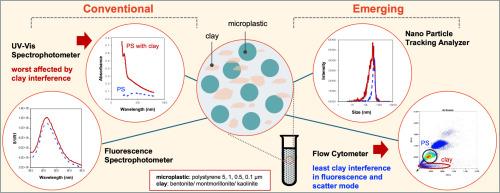Performance of Analytical Techniques for Microplastic and Nanoplastic Quantification in the Presence of Clay
IF 12.4
1区 环境科学与生态学
Q1 ENGINEERING, ENVIRONMENTAL
引用次数: 0
Abstract
Accurate quantification of microplastics (MPs) and nanoplastics (NPs) in laboratory and environmental samples remains challenging, particularly in complex matrices such as clay. While ultraviolet-visible (UV-Vis) and fluorescence spectrophotometry (FS) are widely used due to their simplicity and high throughput, their reliability diminishes in the presence of clay. Existing separation methods are often ineffective for MP/NPs and may introduce additional errors during the measurement process. Advanced analytical techniques have shown high accuracy for monodisperse MP/NP solutions, yet their reliability in clay-rich environments remains untested. This study evaluates two such techniques, flow cytometry (FCM) and nanoparticle tracking analysis (NTA) – in both fluorescence and non-fluorescence modes, alongside UV-Vis and FS, assessing their performance in measuring polystyrene (PS) MP/NPs (0.1–5 µm) at varying concentrations, in the presence of kaolinite, montmorillonite and bentonite clays. Tests with clay-free monodisperse MP solutions indicated that UV-vis and FS can measure wide range of MP size and concentrations, while NTA and FCM showed effective detection within narrower size range, < 0.5 µm and > 0.5 µm, respectively. The presence of clay adversely affected all methods to varying extents. UV-Vis was the most susceptible, with errors exceeding 10% at PS/clay mass ratios above ∼ 1. In contrast, FCM was the least affected due to its ability to distinguish particles based on size, shape, and granularity. Fluorescence-based detection offered a clear advantage in separating MPs from clay interference, allowing FS, NTA, and FCM to show improved measurement accuracy compared to non-fluorescent based measurements. However, FS accuracy declined as PS/clay ratio dropped below 0.01 due to autofluorescence from clays. Overall, FCM emerged as the most suitable method for rapid and reliable quantification of MP/NPs in clay-rich matrices, using both fluorescent and non-fluorescent detection modes. These findings provide direct practical advantage for laboratory-scale investigations and a foundation for developing protocols for fast, accurate MP/NP quantification in clay rich environmental matrices.

粘土存在下微塑性和纳米塑性定量分析技术的性能
在实验室和环境样品中准确定量微塑料(MPs)和纳米塑料(NPs)仍然具有挑战性,特别是在粘土等复杂基质中。虽然紫外-可见(UV-Vis)和荧光分光光度法(FS)由于其简单和高通量而被广泛使用,但它们的可靠性在粘土的存在下降低了。现有的分离方法通常对MP/NPs无效,并且可能在测量过程中引入额外的误差。先进的分析技术已经显示出单分散MP/NP溶液的高精度,但它们在富含粘土的环境中的可靠性仍有待检验。本研究评估了两种这样的技术,流式细胞术(FCM)和纳米颗粒跟踪分析(NTA) -在荧光和非荧光模式下,以及UV-Vis和FS,评估了它们在高岭石、蒙脱土和膨润土存在下测量不同浓度聚苯乙烯(PS) MP/NPs(0.1-5µm)的性能。无粘土单分散MP溶液的测试表明,UV-vis和FS可以测量较宽的MP尺寸和浓度范围,而NTA和FCM在较窄的尺寸范围内有效检测,分别为<; 0.5 µm和>; 0.5µm。粘土的存在不同程度地对所有方法产生不利影响。UV-Vis是最易受影响的,在PS/粘土质量比大于1时,误差超过10%。相比之下,FCM受影响最小,因为它能够根据大小、形状和粒度区分颗粒。基于荧光的检测在分离MPs和粘土干扰方面具有明显的优势,与基于非荧光的测量相比,FS、NTA和FCM显示出更高的测量精度。然而,由于粘土的自身荧光,当PS/clay比低于0.01时,FS的准确性下降。总的来说,FCM是最适合快速、可靠地定量富粘土基质中MP/NPs的方法,同时使用荧光和非荧光检测模式。这些发现为实验室规模的研究提供了直接的实用优势,并为开发富粘土环境基质中快速、准确的MP/NP定量方案奠定了基础。
本文章由计算机程序翻译,如有差异,请以英文原文为准。
求助全文
约1分钟内获得全文
求助全文
来源期刊

Water Research
环境科学-工程:环境
CiteScore
20.80
自引率
9.40%
发文量
1307
审稿时长
38 days
期刊介绍:
Water Research, along with its open access companion journal Water Research X, serves as a platform for publishing original research papers covering various aspects of the science and technology related to the anthropogenic water cycle, water quality, and its management worldwide. The audience targeted by the journal comprises biologists, chemical engineers, chemists, civil engineers, environmental engineers, limnologists, and microbiologists. The scope of the journal include:
•Treatment processes for water and wastewaters (municipal, agricultural, industrial, and on-site treatment), including resource recovery and residuals management;
•Urban hydrology including sewer systems, stormwater management, and green infrastructure;
•Drinking water treatment and distribution;
•Potable and non-potable water reuse;
•Sanitation, public health, and risk assessment;
•Anaerobic digestion, solid and hazardous waste management, including source characterization and the effects and control of leachates and gaseous emissions;
•Contaminants (chemical, microbial, anthropogenic particles such as nanoparticles or microplastics) and related water quality sensing, monitoring, fate, and assessment;
•Anthropogenic impacts on inland, tidal, coastal and urban waters, focusing on surface and ground waters, and point and non-point sources of pollution;
•Environmental restoration, linked to surface water, groundwater and groundwater remediation;
•Analysis of the interfaces between sediments and water, and between water and atmosphere, focusing specifically on anthropogenic impacts;
•Mathematical modelling, systems analysis, machine learning, and beneficial use of big data related to the anthropogenic water cycle;
•Socio-economic, policy, and regulations studies.
 求助内容:
求助内容: 应助结果提醒方式:
应助结果提醒方式:


